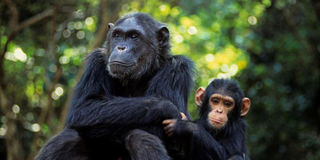Scientists create antibody to protect chimps from deadly virus

Chimpanzees in the wild. If chimps or gorillas are infected with Ebola, there is a 90-98 per cent chance that they will die. PHOTO | KARL AMMANN
What you need to know:
- In laboratory tests with 10 captive chimpanzees, the vaccine was shown to generate a robust immune response to the Ebola virus.
- The outbreak of Ebola in west Africa that started in 2013 highlighted the devastating toll that the disease can have in humans.
Scientists have developed a vaccine to shield endangered chimpanzees and gorillas against Ebola.
The vaccine is administered orally to the animals by disguising it in food and left out for the animals to eat, making it easier and less traumatic compared to darting.
A small trial suggests that a vaccine against Ebola could protect gorillas and chimps from the deadly disease, which has devastated great ape populations, particularly gorillas, where the virus is estimated to have wiped out a third of the primates.
“These results suggest that oral vaccination holds great promise as a tool for the conservation of apes and other endangered tropical wildlife,” the scientists said.
In laboratory tests with 10 captive chimpanzees, the vaccine — known as filorab1 — was shown to be safe and to generate “a robust immune response” to the Ebola virus, researchers reported in the journal Scientific Reports.
Because chimpanzees and gorillas are so closely related, the researchers assumed that if the vaccine worked in chimps it would work for gorillas also.
Six animals were given the drug by mouth and four were injected with it.
The chimp trial was conducted at the University of Louisiana Lafayette’s New Iberia Research Center before the United States ended captive chimpanzee biomedical research programmes, now banned in all developed countries.
Dr Peter Walsh, from the University of Cambridge, who led the research, acknowledged the trial was small, but said it was stopped early when a ban on the use of chimpanzees in biomedical research came into force in the US in 2015.
HUGE RISK
Despite exceptions for veterinary emergencies or research for species conservation, there are no laboratories with captive chimps left.
This means that the vaccine will have to be given to animals in the wild to determine the best dosage.
“We have to use non-invasive methods. For instance we have to get antibodies from faeces rather than draw and test blood to determine whether or not the vaccine worked,” Dr Walsh explained.
Like humans, chimpanzees and gorillas can get infected with Ebola and suffer from epidemics.
To protect them from the disease as well as prevent it from spilling onto human populations, researchers have been working on an oral vaccine to combat Ebola in the wild.
However, some conservationists warn that this would be difficult and has risks.
“Now that we have shown this is a safe vaccine, it is really a moral imperative that we use it. The disease is a huge threat to gorillas right now. We vaccinate our children, we vaccinate livestock, we vaccinate our pets, we vaccinate wildlife - why aren’t we vaccinating our closest relatives?” said Dr Walsh.
Dr Walsh is currently in the process of developing a system for putting the vaccine into bait that apes will eat in the wild.
Only then can the vaccine be rolled out, to gorillas first and chimps later.
Liz Macfie, vice chair of the International Union for Conservation of Nature’s section on great apes, said that the results of the trial were encouraging and promising. But added that rolling out a wider vaccination programme would be difficult.
“Some wild apes are habituated to tourists or researchers’ presence, so some you can approach. But the majority of the populations are completely unhabituated and it would be very difficult to provide a vaccine to a group of unhabituated apes,” she said.
She also said there were some concerns about safety.
“There is always the risk when you use a vaccine on wild animals that there is an associated pathology or infections that might spread… It is a small sample size that [this vaccine] has been tested in and we do not really know about all of the other effects.”
EBOLA OUTBREAK
Ebola was first identified in Zaire — now the Democratic Republic of the Congo — in 1976.
Since then, there have been several outbreaks of the deadly disease.
The outbreak of Ebola in west Africa that started in 2013 highlighted the devastating toll that the disease can have in humans, with more than 11,000 people estimated to have died.
For humans, at least 15 Ebola vaccines are being designed by laboratories worldwide – one of which the World Health Organization said last December may be “up to 100 per cent effective” and could be available in 2018.
Some scientists say gorillas could benefit from immunisation, too. And Ebola in humans and great apes — which include gorillas, orangutans, chimpanzees, and bonobos — is closely linked.
Although the 2014 outbreak is not thought to have started this way but instead through contact with Ebola-carrying bats, many human outbreaks have started after people came into contact with infected gorillas and chimpanzee carcasses or bush meat.
The disease is extremely deadly for our primate cousins: if chimps or gorillas are infected, there is a 90-98 per cent chance that they will die.



